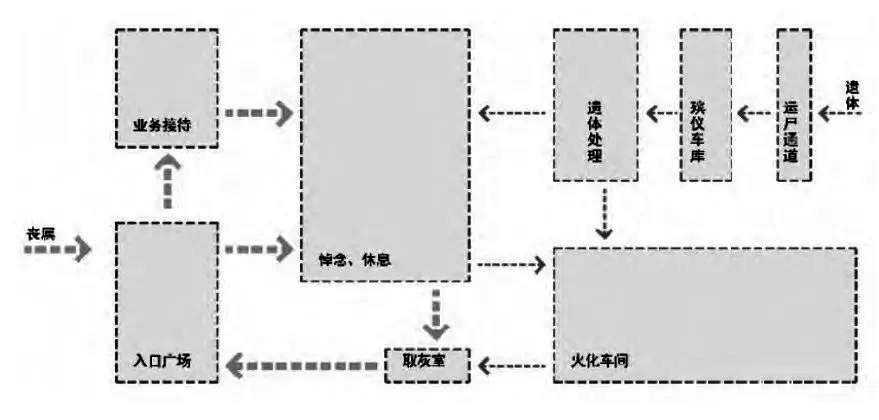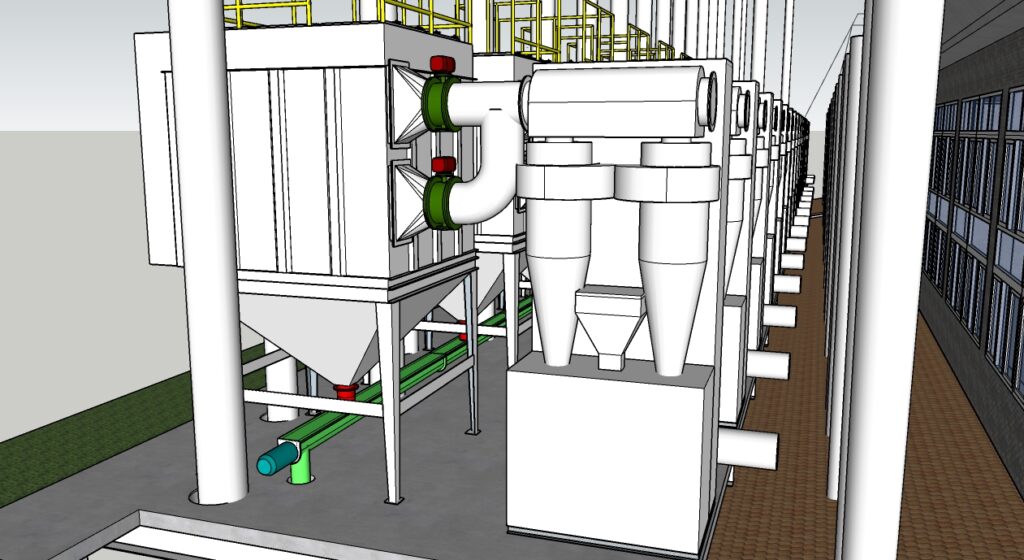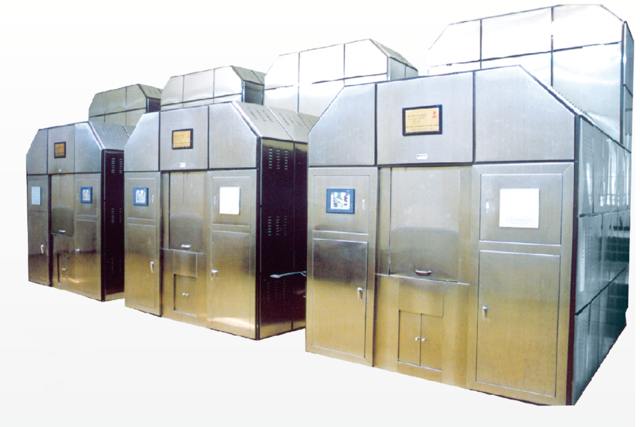With the growth of China's population and the continuous worsening of the aging issue, the construction of funeral and burial buildings in small and medium-sized cities has increased significantly, while architects engaged in the design of funeral home buildings are relatively few. This paper briefly reviews the historical changes of funeral culture, analyzes the impact of contemporary views on life and death on the venue of funeral home buildings, and takes the new funeral home in Yongfeng County as an example. It discusses the architectural design methods of funeral homes with reasonable functions, clear circulation, and characteristic space attributes from aspects such as project site selection, functional layout, circulation organization, characteristic space, and form and color, providing some experience for the design of similar types of buildings.
1. Cultural Background
"Shuowen Jiezi": "Bin, dead in the coffin, about to move the coffin for burial, and the guests meet it." Funeral ceremony, that is, the body is in the coffin but not yet buried, and it is treated with the etiquette of a guest. Culturally speaking, China's funeral culture or funeral ceremony culture originated from the ancients' fear of the unknown world and the self-consolation of the living. The concept of "treating the dead as if they were alive, treating the deceased as if they were still present" was deeply rooted in ancient China, and the funeral culture etiquette was formed accordingly. The implementation of the five mourning garments to regulate crimes further elevated it to the level of law. Funeral activities have become more and more complex under the influence of funeral culture etiquette and systems. With the progress of modern society and the deepening of funeral reforms, people have a rational understanding of life and death, and the significance of funeral activities has become pure: it is a remembrance of the deceased and also a self-consolation for the living. Funeral activities have shifted from focusing more on the deceased to mainly serving the living. As a result, funeral homes, as a modern public service building dominated by function and circulation, have developed.
As an architectural activity, ancient Chinese funeral buildings were mainly reflected in the tombs and burials of emperors and nobles. Modern funeral home buildings are a new type of funeral building influenced by Western culture and emerged with the popularization of cremation. Funeral homes are venues for funeral activities and ceremonies, providing some or all funeral services such as body disposal, cremation, mourning, and ashes storage. While meeting the basic functional needs mentioned above, funeral homes must also be influenced by the funeral customs of different regions, and their process and traffic circulation design must comply with the local funeral customs.
2. Project Overview
Yongfeng County is located in the central part of Jiangxi Province and the northeast side of Ji'an City. The new funeral home and the supporting urban public welfare ecological cemetery in Yongfeng County, based on the overall development needs of Yongfeng County, aim to build a comprehensive, eco-friendly, and one-stop funeral service place that integrates funeral, burial, and worship, to solve the funeral service needs of the whole county for the next 50 years. The annual body processing capacity of the new funeral home in Yongfeng County is estimated to be about 3100 bodies, belonging to a Class IV funeral home. Its functions include a mourning hall, a crematorium building (including body processing), and a service building (including business reception, office, etc.), with a total construction area of 6851 square meters.
3. Project Site Selection
The existing funeral home in Yongfeng County is located in the southeast side of Yongfeng County, about 5 kilometers away from the city center. It was built many years ago, with outdated facilities and equipment, high maintenance costs, and its supporting cemetery is almost saturated, with limited development space. The new funeral home in Yongfeng County is located on Xihua Mountain, about 10 kilometers away from the city center, far from the urban residential area and avoiding rural settlements. The base is surrounded by mountains, which can effectively reduce the impact of the funeral home and related funeral service facilities on the surrounding environment.
4. Functional Layout
The scale of funeral homes varies, and the complexity of their functions is also different. The new funeral home in Yongfeng County is divided into three areas after functional integration: service reception area, mourning rest area, and body processing and cremation area. The functional layout needs to comply with the general process of holding funeral activities in the local area (Figure 1). Based on the current topography, the layout is arranged from southeast to northwest as the entrance square, service building, mourning building, and cremation building (Figure 2).

Figure 1 Funeral Process Diagram

Figure 2 Left: Functional Circulation Analysis; Right: Architectural Combination Plan
The service building includes functions such as a service hall, kitchen, canteen, office, meeting room, etc.
The mourning building is located in the central position of the entire building group, with one large and five small mourning halls, totaling six. The area of the large mourning hall is 233.92 square meters, and the area of the small mourning hall is 169.20 square meters. The mourning halls are connected by an open corridor, with a lobby facing the entrance square and the valley side. Each mourning hall has a rest room, reception room, and equipment room. In addition, there is an incineration live broadcast room near the side close to the cremation building.
The cremation building is located on the north side of the building group. The eastern part of the cremation building is the cremation function area, including the cremation building entrance hall, changing room, cremation room, and ashes temporary storage room, etc., with six body cremation furnaces installed in the cremation room. The body processing and corpse transport garage are located in the western part of the cremation building, where the morgue can accommodate about 20 bodies, with a body dissection room; there are two corpse transport garages, which can accommodate six corpse transport vehicles (Figure 2).
5. Circulation Organization
There are four types of traffic circulation in the new funeral home in Yongfeng County, namely the bereaved flow line, staff flow line, body flow line, and corpse transport flow line. Bereaved flow line: The bereaved enter the circular corridor of the service building and mourning building through the entrance square to reach each mourning hall; Staff flow line: Staff can enter each functional space through the corridors connecting each building unit to provide convenient services; Body flow line: The body flow line is connected with each mourning hall through the corridor from the body processing space unit and enters the cremation function area; Corpse transport flow line: An independent entrance is set up for the corpse transport vehicle, entering from the north side of the building to reach the body processing function area. Each traffic flow line is simple and clear, avoiding unnecessary intersections (Figure 2).
6. Characteristic Spaces
1. Leading Space
The design of the leading space in the new funeral home park in Yongfeng County considers the philosophy of Feng Shui: pursuing the ancient Chinese tomb planning design concept of "matching the tomb system with the landscape" and "the unity of heaven and man". The main entrance channel of the funeral home is located between two highlands, one is to reduce the amount of earthwork, and the other is to use the mountains on both sides to form a double que, increasing the ritual sense of the leading space of the funeral home. To keep the longitudinal slope of the road within a reasonable range, the main channel is about 300 meters long, winding to the square in front of the museum. Entering the main channel from the museum area gate, after two turns of the main channel, you will arrive at the funeral home. This terrain-following treatment method increases the interest of the funeral home entrance space and reduces the destruction of the mountain body. The leading space culminates in the square in front of the funeral home, and the space suddenly opens up (Figure 3).

Figure 3 Leading Space
2. Separate Gate Hall
Ancient Chinese architecture is characterized by the layout of group buildings, which is very suitable for buildings like funeral homes: small in volume, not high in floors, and not large in the area of each functional unit. The orderly group building layout of the new funeral home in Yongfeng County forms a solemn and orderly combination space form. The setting of the gate hall is the prologue, symbol, and symbol of the combined space. The separation of the gate hall is an important characteristic of the composition of ancient Chinese group buildings, which is the embodiment of the spirit of etiquette in architecture. Its main function is to form a spatial distinction between the inside and the outside, and thus form a courtyard space (Figure 4).

Figure 4 Comparison of Ming Changling and the General Plan of the New Funeral
Home in Yongfeng County (Left: Huaxia Craftsman, Author's Addition)
3. Courtyard and Corridor
Under the guidance of the leading space, enter the main building group of the new funeral home in Yongfeng County. The service building and its front square are the turning point of the leading space sequence. Under the hint of the gate hall, people enter the courtyard space and arrive at the main body of the funeral home - the mourning hall through the courtyard space. The main courtyard space enclosed by the mourning hall has a scale of about 50m×50m, forming two types of internal and external space forms. The mourning halls are appropriately separated to form small secondary courtyard spaces, which further optimize the lighting method of the mourning halls and reduce the mutual interference between the mourning halls. The courtyard formed between the mourning hall and the cremation building on the north side mainly plays a role in separating but not leaving (Figure 5).

Figure 5 Spatial Structure Analysis
The corridor is divided into inner and outer corridors in terms of function. The inner corridor is the functional space for the bereaved to enter each mourning hall through the front square and gate hall. The outer corridor connects the mourning hall, the cremation function area of the cremation building, and the body processing area, which is the functional space of the internal corpse transport channel. The corridor makes each functional unit independent and non-interfering, while functionally connected and convenient to use.
7. Form and Color
As the main venue for funeral activities, the funeral home building needs to comply with the complex psychological characteristics of the bereaved: mourning while facing death calmly. Being impartial can meet the psychological characteristics of most bereaved. From ancient tombs to contemporary funeral homes, the sloped roof has a strong spiritual significance. Pursuing a stable structural form has a deep sense of identity in people's psychology. At the same time, the sloped roof can also be well integrated with the natural environment such as mountains (Figure 6).
The form of the new funeral home building in Yongfeng County is mainly reflected in the use of sloped roofs. The sloped roof protrudes about 2 meters, and the eaves are appropriately retracted to form a concave-convex building outline, creating a sense of floating of the roof. While expressing the solemn attribute of the funeral home building, it reduces the spatial oppression brought to the bereaved by the large roof and enriches the facade level of the building. The repeated use of the corridor element makes the building more light and ethereal. The change in the height and form of the roof makes the building group unified and rich (Figure 6).
The main color of the building is mainly off-white, with appropriate use of dark brown. Combined with the building form, it is mainly light and mainly dark, one light and one dark, catering to the psychological needs of the bereaved who are sad and relieved.

Figure 6 Left: Bird's-eye view effect; Upper right: Gate hall effect; Lower right: Mourning hall effect
8. Conclusion
With the advancement of the funeral industry, funeral service facilities have been developed and improved. As a modern public service building, the funeral home must first meet the basic requirements of the function and circulation of the funeral home; secondly, it should reflect the local traditional customs and regional architectural style as much as possible, and local customs will often have an important impact on the functional layout; again, based on the functional layout and combined with the terrain to form a memorable place and space, and in the architectural form and color to enhance or alleviate the complex psychological feelings of the bereaved. The above are the main issues to be resolved in the process of funeral home architectural design.
(This article is by Xu Yongmin and Jiang Lifeng of Shanghai Urban Architectural Design Co., Ltd., the design unit of Yongfeng County)
PS:With the modernization and heightened environmental requirements of the funeral industry, selecting efficient and eco-friendly cremation equipment has become particularly important. The cremation machines we offer meet not only the functional needs of modern funeral homes but also take into account environmental protection and humanized design. Our cremation machines use the latest technology to perfectly combine high efficiency with low emissions, aiming to provide a solution that respects life and protects the environment for funeral services.
We invite you to contact us to learn more about our cremation machines. Let's work together to promote the green development of the funeral industry and provide dignity for the deceased and comfort for the living. Choosing our cremation machines means choosing a future of funeral services that is more environmentally friendly, efficient, and humanized. Take action now and join us in opening a new chapter in funeral services.



